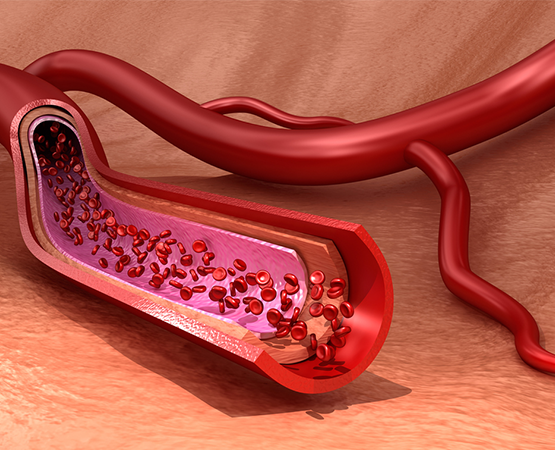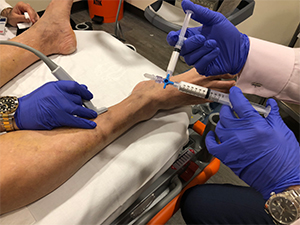VARICOSE VEINS ARE NOT ONLY YOUR LEGS,
AFFECTS YOUR WHOLE LIFE
What is a Varicose Vein and symptoms?
How Do Leg Veins Work?
While the blood in the veins of the upper half of the body can easily return to the heart with the help of gravity, the veins in the legs have to carry in the opposite direction of gravity. For this reason, there are numerous and one-way valves in them, and around them there are muscles that contract and thus squeez the veins from the bottom to the top. The contraction of the leg muscles opens the valves inside the veins and pushes the blood upwards. In this way, blue blood travels to the heart in the opposite direction of gravity. When the muscles relax, the valves close and blood is prevented from escaping back to the feet.

What Is Venous Insufficiency?
Due to the improper functioning of the valves in the leg veins, the blue blood carried by the veins escapes back to the feet. Blood pools in the ankles and calf. As a result of the increase in pressure in the veins, the veins expand and bend. The valves in the enlarged vein completely lose their ability to retain blood. This is called Venous Insufficiency or Leg Reflux.
What are varicose veins?
All the symptoms that the disease of venous insufficiency manifests are called varicose veins. Varicose veins show themselves in different ways, from mild to severe.
Visual Symptoms
- The first symptom of the disease is the escape of fluid from the sick veins between the leg tissues and the edema (swelling) that extends from the foot to the ankle and scratching below the knee with an increasing character during the day.
- Then, red, blue, purple colored spider veins or telangiectases (thin capillaries with a diameter of 1-2 mm) appear, such as a spider or tree root, extending around from a dark midpoint.
- During the period without treatment, while the number and diameter of these veins increase, their colors change and reticular veins (vessels with a diameter of 2-3 mm) appearing in blue and green colors develop.
- The result is large varicosities (veins wider than 3 mm) that look like nuts and spaghetti pasta under the skin.


Comfort Disorder
Due to the progression and development of varicose veins, the comfort of life begins to deteriorate gradually. Depending on this, pain, cramps, itching in the form of burning or excessive fatigue, which increases during the day, begin to be expressed. One of the great characteristics of this pain is that it is felt not when we are moving, but when we stand, sit or lie down.
In the evening, due to the unbearability of the pain when going to bed, we want to take the feet out of the duvet, move them, put a pillow underneath. This is the most important indicator of the condition called Restless Leg Syndrome.
Advanced Stage / Vital Signs
Intense itching in the ankles, bleeding under the skin and brown discoloration indicate that the disease has reached an advanced stage. After this period, wounds (ulcers) may occur on the leg that will barely heal in 3-4 months.
Since the flow rate of blood in the excessively tortuous and wide vessels that appear will also diminish, blood clots may form in the vein and superficial venous or deep venous thrombosis may develop.

The clot formed in the deep veins can migrate from its primary origin and can go to the lungs. In this case, the resulting Pulmonary Embolism (Pulmonary Embolism) may pose a serious threat to life.

DIAGNOSTIC METHODS
Since venous insufficiency is a vascular disease, the first examination should be performed by a cardiovascular surgery specialist. The patient should be informed about the path to be followed.
- Venous Doppler ultrasound examination of the leg (Duplex Test) should be performed to see which veins and which vein valves are affected along with the level of the disease.
- After the severity of venous insufficiency is understood, treatment should be started by a specialist surgeon in the field.
- No simple or comprehensive treatment should be applied to patients who have not undergone leg Doppler ultrasound examination.

TREATMENT METHODS
- If pressure socks are worn continuously, some complaints and symptoms may be temporarily suppressed and the course of the disease may be slowed down.
- The success rate that laser treatment can provide in the face and body is lower for thin capillary varicose veins on the legs. Permanent burn marks can be caused as a result of superficial laser treatments that are not performed under the control of a doctor or on veins thicker than 2 mm.
- Some drugs used in cases of venous insufficiency involving very advanced and deep veins do not treat the existing disease, but can only alleviate the patient’s pain and complaints.
- Classical surgical treatment: It is the removal or ligation of the diseased vein after making incisions in the groin and knee under anesthesia. It has negative consequences such as permanent loss of sensation in the leg, bruising and recurrence of the disease up to 40-70% within a five-year period.
Modern Treatment Methods

Visual Foam Sclerotherapy
It is the injection of the foamy liquid obtained by mixing the drug called Polidocanol-Aethoxysklerol with carbon dioxide and oxygen into the sick veins with the help of very thin needles. An interaction occurs in the vein wall in contact with the drug, the vessel hardens and closes, and the vessel is absorbed by the body over time (an average of 3 weeks to 2 months depending on the diameter of the treated vessel). In addition to cosmetic healing, regional leg pain, burning and cramps can be eliminated. Successful results are obtained in 80% of patients undergoing sclerotherapy.

Ambulatory Phlebectomy
The veins to be removed are first marked (mapping). Then, under local anesthesia, the large spaghetti looking vein is removed through 1mm large incisions with the help of a hook. Due to the small size of the incision and the fact that it does not require stitches, cosmetic healing is very good and fast. After the treatment, normal daily life is returned immediately.

Endovenous Trunkal Ablation
Among the latest innovations in the treatment of varicose veins is Endovenous Trunkal Ablation. Today, the classical varicose vein surgery method is replaced by this new procedure with a five-year success rate of 86%.

Chemical Ablation/Blockage Under Doppler Guidance
The lower of ends of the treated veins (10-20cms close to the ankle) with Endovenous Trucal Ablation are very close to neighbouring nerves. Therefore E.V.T.A. should not be performed in those areas to avoid from nerve damages. On the other hand, if these parts of the diseased veins are left without any treatment, the preoperative symptoms of the patient may continue or the disease can show recurrence. Doppler ultrasound should be repeated 7-10 days after Endovenous Truncal Ablation to find out the success of the procedure and to find out if these distal ends of the veins are also diseased. If this is the case, then a foam sclerosant solution is injected into these areas in outpatients’ setting. The name of the method is Doppler Guided Chemical Ablation/Blockage and takes about 5-15minutes.
Frequently Asked Questions (FAQ)
- On the day of treatment, consuming as much fluids as possible and walking is important.
- If a pain killer is needed for any reason, a drug containing paracetamol can be taken. Drugs containing anti-inflammatory agents should not be taken until 48 hours before and 48 hours after treatment.
- Until full recovery, the treated area may look worse than before. This image will disappear with the absorption of iron in the vein and vein. The process may differ from person to person, and some gels may be recommended to speed it up. Bruised areas can be massaged with ice.
- Avoid sun baths, sauna and superficial laser treatments with different purposes and difficult exercises for 2 weeks. Weight should not be lifted for about 3 months.
- If any unexpected symptoms are encountered or if there is a problem with the treatment, the doctor should be consulted immediately.
Endovenous Truncal Ablation, Ambulatory Phlebectomy and Doppler Guided Chemical Ablation can be performed any time during the year. However, cosmetic approaches such as Visual Foam Sclerotherapy and Visual Laser should not be performed during the summer time.
If the venous insufficiency is not treated, the severity of the disease will increase, and complaints such as swelling, cramping, burning and pain in the legs will appear and exacerbate in addition to cosmetic disorders. For large, spaghetti-looking varicose veins, the risk of clot formation and related pulmonary embolism as well as wounds that do not heal for months at the ankle level will increase.
Almost all private health insurance companies cover the current varicose vein treatments for medical treatment purposes (Endovenous Truncal Ablation, Ambulatory Phlebectomy, Doppler Guided Chemical Ablation). They do not cover capillary varicose vein treatments (Visual Foam Sclerotherapy or Laser), which they describe as cosmetic purposes. Insurance companies require a detailed physical examination and Doppler report before payment approval.
Since the eliminated vein is unhealthy in the first place, it harms our body instead of benefiting it. Closure / removal of venous insufficiency veins by any of modern methods does not cause any problems. Most importantly, the main road that delivers blood to the heart, that is, the deep veins in the innermost parts of the leg, are not touched. Since there are many veins in the legs, the task of the sick veins will be taken over by the healthy veins.
